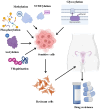Unraveling role of ubiquitination in drug resistance of gynecological cancer
- PMID: 38859858
- PMCID: PMC11162667
- DOI: 10.62347/WYKZ9784
Unraveling role of ubiquitination in drug resistance of gynecological cancer
Abstract
Chemotherapy is the principal treatment for advanced cancer patients. However, chemotherapeutic resistance, an important hallmark of cancer, is considered as a key impediment to effective therapy in cancer patients. Multiple signaling pathways and factors have been underscored to participate in governing drug resistance. Posttranslational modifications, including ubiquitination, glycosylation, acetylation and phosphorylation, have emerged as key players in modulating drug resistance in gynecological tumors, such as ovarian cancer, cervical cancer and endometrial cancer. In this review article, we summarize the role of ubiquitination in governing drug sensitivity in gynecological cancers. Moreover, we describe the numerous compounds that target ubiquitination in gynecological cancers to reverse chemotherapeutic resistance. In addition, we provide the future perspectives to fully elucidate the mechanisms by which ubiquitination controls drug resistance in gynecological tumors, contributing to restoring drug sensitivity. This review highlights the complex interplay between ubiquitination and drug resistance in gynecological tumors, providing novel insights into potential therapeutic targets and personalized treatment strategies to overcome the bottleneck of drug resistance.
Keywords: PTM; drug resistance; gynecological cancer; target; treatment; ubiquitination.
AJCR Copyright © 2024.
Conflict of interest statement
None.
Figures


Similar articles
-
Immune checkpoint blockades in gynecological cancers: A review of clinical trials.Acta Obstet Gynecol Scand. 2022 Sep;101(9):941-951. doi: 10.1111/aogs.14412. Epub 2022 Jun 25. Acta Obstet Gynecol Scand. 2022. PMID: 35751489 Free PMC article. Review.
-
[Clinical analysis of 23 cases with simultaneous double primary gynecological malignant tumors].Zhonghua Fu Chan Ke Za Zhi. 2022 May 25;57(5):352-360. doi: 10.3760/cma.j.cn112141-20220214-00086. Zhonghua Fu Chan Ke Za Zhi. 2022. PMID: 35658326 Chinese.
-
Application of natural polysaccharides and their novel dosage forms in gynecological cancers: therapeutic implications from the diversity potential of natural compounds.Front Pharmacol. 2023 Jun 13;14:1195104. doi: 10.3389/fphar.2023.1195104. eCollection 2023. Front Pharmacol. 2023. PMID: 37383719 Free PMC article. Review.
-
Implication of protein post translational modifications in gastric cancer.Front Cell Dev Biol. 2025 Feb 4;13:1523958. doi: 10.3389/fcell.2025.1523958. eCollection 2025. Front Cell Dev Biol. 2025. PMID: 39968176 Free PMC article. Review.
-
Posttranslational modifications in pathogenesis of PCOS.Front Endocrinol (Lausanne). 2022 Oct 7;13:1024320. doi: 10.3389/fendo.2022.1024320. eCollection 2022. Front Endocrinol (Lausanne). 2022. PMID: 36277727 Free PMC article. Review.
Cited by
-
TRIM19 enhances the chemosensitivity of endometrial cancer by regulating the TBX2/NRF2 axis.Discov Oncol. 2025 Jun 4;16(1):997. doi: 10.1007/s12672-025-02717-7. Discov Oncol. 2025. PMID: 40465083 Free PMC article.
References
-
- Siegel RL, Miller KD, Wagle NS, Jemal A. Cancer statistics, 2023. CA Cancer J Clin. 2023;73:17–48. - PubMed
-
- Nishio S. PD4-2 - novel targeted therapies in uterine carcinosarcomas. Ann Oncol. 2019;30:vi50.
-
- Bhattacharjee R, Dey T, Kumar L, Kar S, Sarkar R, Ghorai M, Malik S, Jha NK, Vellingiri B, Kesari KK, Pérez de la Lastra JM, Dey A. Cellular landscaping of cisplatin resistance in cervical cancer. Biomed Pharmacother. 2022;153:113345. - PubMed
-
- Schmitz JC, Liu J, Lin X, Chen TM, Yan W, Tai N, Gollerkeri A, Chu E. Translational regulation as a novel mechanism for the development of cellular drug resistance. Cancer Metastasis Rev. 2001;20:33–41. - PubMed
Publication types
LinkOut - more resources
Full Text Sources
